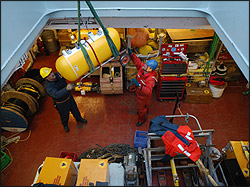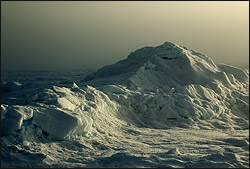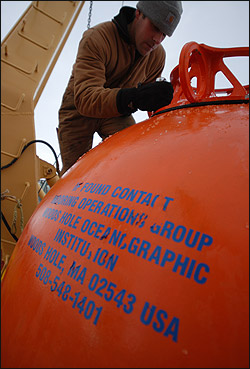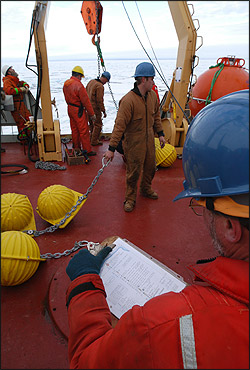Please note: You are viewing
the unstyled version of this website. Either your browser does not support CSS
(cascading style sheets) or it has been disabled. Skip
navigation.
Chris LinderAugust 26, 2005
The next hurdle was the moored profiler, a small 150-pound instrument that makes temperature, salinity, and current measurements as it travels up and down a 2000 meter wire twice a day. The instrument contains a year's worth of data; it is an expensive instrument in itself, but with that data it is now priceless. When about half of the 2000 meter line was on deck, the profiler appeared at the surface. John Kemp quickly jumped in the man basket and was lowered down to the waterline to attach a line to the instrument. It was quickly hauled aboard and stowed safely in the hold. Now all that remained was the top float, which contains an upward-looking sonar for measuring the ice draft (amount of ice below the surface). More importantly, though, is the float itself, because without the float, we can't redeploy Mooring C. As we approached the end of the line, there was still no sign of the float. Suddenly, the line went taut in a line arcing out from the ship. "Hold that!" yelled John, stopping the operation. "We have to be very careful here" John explained "if we cut the line on the ice, we may never find that float. Now we need to follow the leash." If an icebreaker can be described as moving daintily, that was how Captain Potts maneuvered the Louis in a chase after the line. John slowly hauled in, until the buoy suddenly popped out from under a jumble of multi-year ice just off the starboard bow. Everyone breathed a sigh of relief. In a few minutes the saga of our toughest mooring recovery was over. By the time the deck was cleaned up the time was 1AM. Just after breakfast, the deck department and the mooring team were back on deck with fresh instruments, ready to send Mooring C back down to collect more data. Unlike last night's epic recovery, the deployment went as smoothly as all of the other deployments. By early afternoon, an exhausted John Kemp pulled the quick release and dropped the mooring straight down into the midnight blue water. Now we are southward bound, bashing through the pack ice along 140W longitude. As beautiful as the tall pressure ridges and blue multi-year ice are, we are eager to leave them behind for smoother sailing and easier science stations. Last updated: October 7, 2019 | ||||||||||||||||||||||
Copyright ©2007 Woods Hole Oceanographic Institution, All Rights Reserved, Privacy Policy. | ||||||||||||||||||||||






